Using color theory in photography can transform ordinary photos into compelling visual narratives. By understanding how colors interact and evoke emotions, photographers can strategically use color to elevate their work.
1. Understanding Color Theory Basics
The foundation of color theory is the color wheel, a circular representation of colors arranged according to their chromatic relationships. Primary colors—red, blue, and yellow—form the basis of all other hues. Secondary colors, which include green, orange, and purple, are created by mixing two primary colors. Tertiary colors are formed by mixing primary and secondary colors.
2. The Power of Color Harmony
Color harmony refers to the aesthetically pleasing arrangement of colors. It is essential for creating balanced and engaging photos. Complementary colors are opposite each other on the color wheel, like red and green, and they create high contrast, vibrant looks. Analogous colors sit next to each other and offer a more subdued, harmonious feel. Triadic color schemes use three evenly spaced colors on the wheel for dynamic yet balanced compositions.
3. The Role of Color Temperature
Color temperature, measured in Kelvin, plays a critical role in setting the mood of a photograph. Warm colors such as reds, yellows, and oranges convey warmth and energy, often evoking feelings of coziness or excitement. Cool colors like blues and greens often produce a calming effect, suggesting tranquility or melancholy. Photographers can adjust color temperature in-camera or during post-processing to enhance the mood.
4. Emotional Impact of Colors
Colors have psychological effects that can influence viewers’ emotions. Red typically signifies passion or danger, while blue can indicate serenity or sadness. Green often represents nature and health, while yellow can evoke cheerfulness or caution. By understanding these associations, photographers can use color to tell stories and evoke specific emotions in their audience.
5. Using Color in Composition
Strategically placing color within the frame can guide the viewer’s eye and emphasize focal points. Leading lines created by contrasting colors can draw attention to the photo’s subject. Additionally, negative space, using color, can help highlight a subject by enhancing its isolation in the image. Compositional color balance is crucial for a cohesive image, ensuring that no element overpowers the others.
6. Achieving Depth and Dimension with Color
Depth in photography can be enhanced using color. Atmospheric perspective, where distant objects appear cooler and less saturated, can be simulated using colors to create a sense of depth. Warm colors tend to advance toward the viewer, while cool colors recede, adding dimensionality to the photograph. Incorporating these techniques can make two-dimensional images appear more expansive and engaging.
7. Enhancing Storytelling with Color Palettes
Creating a cohesive color palette can enhance storytelling. For instance, a vintage look might be achieved with muted earth tones, while a futuristic feel could be evoked with neon and metallic colors. Photographers can plan color schemes to align with the narrative they wish to convey, enhancing the overall story through strategic color choices.
8. Black and White Photography and Color Theory
Even in black and white photography, color theory plays a role through contrast and tonal range. Colors translate to shades of gray, and understanding their original hues can help predict their impact in grayscale. By focusing on color contrasts, photographers can create dynamic black and white images with a wide tonal range, elevating them beyond mere color conversion.
9. Mastering Post-Processing for Color Enhancement
Post-processing offers endless opportunities to refine and manipulate colors. Adjustments like saturation, hue, and luminance can enhance or alter the color mood of a photo. Tools like color grading and selective color adjustments allow photographers to fine-tune the color balance, ensuring that the visual narrative is consistent and supports the intended emotional impact.
10. Real-World Applications and Famous Examples
Legendary photographers like Steve McCurry and William Eggleston are known for their masterful use of color. Studying their work highlights how deliberate color choices can define an artist’s style and distinguish their images. Real-world practice, combined with a careful study of impactful photography, can inspire photographers to apply color theory effectively in their own work.
By incorporating these elements of color theory, photographers can transform their images, adding complexity, depth, and emotional resonance to their work. Whether through conscious planning at the time of capture or deliberate editing choices in post-processing, mastering color theory holds the potential to dramatically enhance photography.


